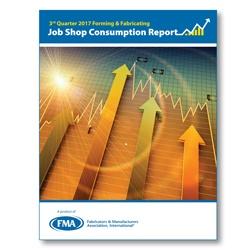- FMA
- The Fabricator
- FABTECH
- Canadian Metalworking
Categories
- Additive Manufacturing
- Aluminum Welding
- Arc Welding
- Assembly and Joining
- Automation and Robotics
- Bending and Forming
- Consumables
- Cutting and Weld Prep
- Electric Vehicles
- En Español
- Finishing
- Hydroforming
- Laser Cutting
- Laser Welding
- Machining
- Manufacturing Software
- Materials Handling
- Metals/Materials
- Oxyfuel Cutting
- Plasma Cutting
- Power Tools
- Punching and Other Holemaking
- Roll Forming
- Safety
- Sawing
- Shearing
- Shop Management
- Testing and Measuring
- Tube and Pipe Fabrication
- Tube and Pipe Production
- Waterjet Cutting
Industry Directory
Webcasts
Podcasts
FAB 40
Advertise
Subscribe
Account Login
Search
Fabricators weather impact of recent storms
Forming and Fabricating Job Shop Consumption Report indicates that fabricators are still in a good place
- By Chris Kuehl
- October 17, 2017

Despite recent storms, metal fabricators still are an optimistic bunch, according to the third quarter Forming and Fabricating Job Shop Consumption Report.
[Editor's note: The following overview is provided by Chris Kuehl of Armada business Intelligence Brief. The entire Forming and Fabricating Job Shop Consumption Report can be downloaded here.]
The following narrative is from the third quarter Forming and Fabricating Job Shop Consumption Report we comment on for the Fabricators and Manufacturers Association. It is a quarterly assessment of what is happening in the small and medium sized fabricating andmanufacturing world. It is a unique report as very few other groups make much of an effort to understand business of this size.
“May you be born in interesting times” is said to be a Chinese curse. There may not be much truth to that assertion but the sentiment is real enough—especially in the last few months. The never-ending cascade of storms and other disasters has altered the course of the economy in some pretty profound ways and these impacts are going to be felt in the months ahead as well. We have already seen a whole host of data points altered by the impact of these storms and it makes assessing the current state of the economya little tricky. There has been some impact on the data for the FFJSCR as well. The pattern of almost every disaster is the same in a country like the U.S.—a country that can and will rebuild and swiftly. The storms initially cost billions of dollars in damage—current estimates are between $50 billion and $90 billion and that is without looking at the costs of Maria and the damage from the western fires. The burning has already cost more than Irma. Once the initial damage is done the second phase starts and this is when billions are spent to rebuild. Two examples are key for the manufacturing community as a whole.
The storms destroyed or damaged over 4 million vehicles and they all have to be replaced as quickly as possible as he hardest hit areas lack much in the way of a mass transit system. The slumping auto sector will not be slumping in the next month or so but once these vehicles have been acquired the previous patterns emerge. Another sector that will draw a lot of attention will be infrastructure as this damage to roads, bridges, buildings and the like will have to be dealt with quickly—again stimulating demand for manufactured goods.
For the next month or so growth numbers will be skewed and so will employment numbers. They will be down further than they should be but will also rebound quickly as the rebuilding starts. These will be skewed positive and it may be early next year before thenumbers calm down.
Operating capacity is one of those measures that get used as a shorthand for much manufacturing activity. The rule of thumb is that anything less than 80 percent capacity utilization is an indication there is too much slack in the business community and that would suggest that there would be relatively less investment in new machinery or new hiring. If the utilization numbers are over 85 percent there will likely be shortages and bottlenecks appearing but it also means that there will be additional purchases of machinery and more hiring. The data from the latest FFJSCR shows that there has been some improvement as far as the capacity numbers are concerned—most respondents have seen stability in the low to mid 70s and that is consistent with the national numbers which have been in the mid to high 70s. It is still short of the 80% at the low end of normal but it is getting closer.
The new order activity is always a good sign for the future—the more the better. Right now, about 37 percent report that new order activity is improving and around 47 percent report that it is stable and that is also consistent with some of the national numbers that are coming from the Purchasing Managers’ Index. The overall PMI is now in the 60s and new order have been there for a few months already. Another piece of good news is that employment is up. The survey shows that over 26 percent of respondents are adding jobs and over 67 percent are stable as far as jobs are concerned. This may well be a sector that is showing some reaction to the storms as there were job gains in those sectors that have been active in the rebuilding effort. The majority of the job losses were in the service sector as these were the dominant sectors in Florida as well as much of the Houston area. The exception in Texas was in the refining sector.
The price of commodities such as steel and aluminum were either going up or remaining stable. The increase was seen for roughly 46 percent of respondents and around 52 percent found that prices were stable. This has been a tricky area to assess as there have been suggestions the U.S. is planning to impose still more tariffs on imported steel. This caused many to buy inventory early so as to avoid some of that hike and that extra demand resulted in higher prices regardless of the tariffs. The problem facing the tariff proposal is that it is ostensibly aimed at the Chinese as a way to keep them from dumping in the U.S. but China doesn’t sell much steel to the U.S. as compared to nations like Canada, Mexico, Japan, South Korea and others. It is possible that some or all of these countries will get an exemption from the tariff and that would mean only a slight reduction in steel imports. Steel users are pressing hard to see this tariff plan abandoned or significantly modified. Aluminum was seeing price drops but demand is still strong from aerospace and some in the appliance sector.
Logistics costs are starting to rise as there has been more demand for these services nationwide and capacity is starting to show the strain. This has been more acute with trucking but there have been hikes in the costs of rail freight as well. Roughly 40 percent see these costs going up and around 60 percent are seeing stability in the sector. Few are seeing declines. This trend is likely to continue and that is another impact from the storms. Most of the available capacity has been gobbled up by the need to ship into the affected areas.
Perhaps the best news is that over 60 percent of the respondents indicate that their planned capital investment is on track and growing and only around 20 percent are declaring their investment plans are on indefinite hold. This is not too surprising given the numbers from capacity usage. There have been many delays as far as this spending has been concerned but there appears to be more general optimism about growth. The most important development for the U.S. manufacturer is that exports are back up now that the dollar has dipped a little and Europe has seen a bit of economic growth return. The EU is still almost 25 percent of U.S. export demand.
In the final analysis there is more enthusiasm than not. Some 58 percent have a generally positive business outlook and only 10 percent have a negative outlook with about 31 percent seeing things as stable. This has been close to the overall pattern in the economy as a whole. There is general confidence in continued growth at around 2.0 to 2.5 percent. This is not gangbusters to be sure but it is certainly respectable.
To download the most recent Forming and Fabricating Job Shop Consumption Report, click here.subscribe now

The Fabricator is North America's leading magazine for the metal forming and fabricating industry. The magazine delivers the news, technical articles, and case histories that enable fabricators to do their jobs more efficiently. The Fabricator has served the industry since 1970.
start your free subscriptionAbout the Author

Chris Kuehl
P.O. Box 733
Lawrence, KS 66044
- Stay connected from anywhere

Easily access valuable industry resources now with full access to the digital edition of The Fabricator.

Easily access valuable industry resources now with full access to the digital edition of The Welder.

Easily access valuable industry resources now with full access to the digital edition of The Tube and Pipe Journal.
- Podcasting
- Podcast:
- The Fabricator Podcast
- Published:
- 04/16/2024
- Running Time:
- 63:29
In this episode of The Fabricator Podcast, Caleb Chamberlain, co-founder and CEO of OSH Cut, discusses his company’s...
- Trending Articles
Tips for creating sheet metal tubes with perforations

JM Steel triples capacity for solar energy projects at Pennsylvania facility

Are two heads better than one in fiber laser cutting?

Supporting the metal fabricating industry through FMA

Omco Solar opens second Alabama manufacturing facility

- Industry Events
16th Annual Safety Conference
- April 30 - May 1, 2024
- Elgin,
Pipe and Tube Conference
- May 21 - 22, 2024
- Omaha, NE
World-Class Roll Forming Workshop
- June 5 - 6, 2024
- Louisville, KY
Advanced Laser Application Workshop
- June 25 - 27, 2024
- Novi, MI



























